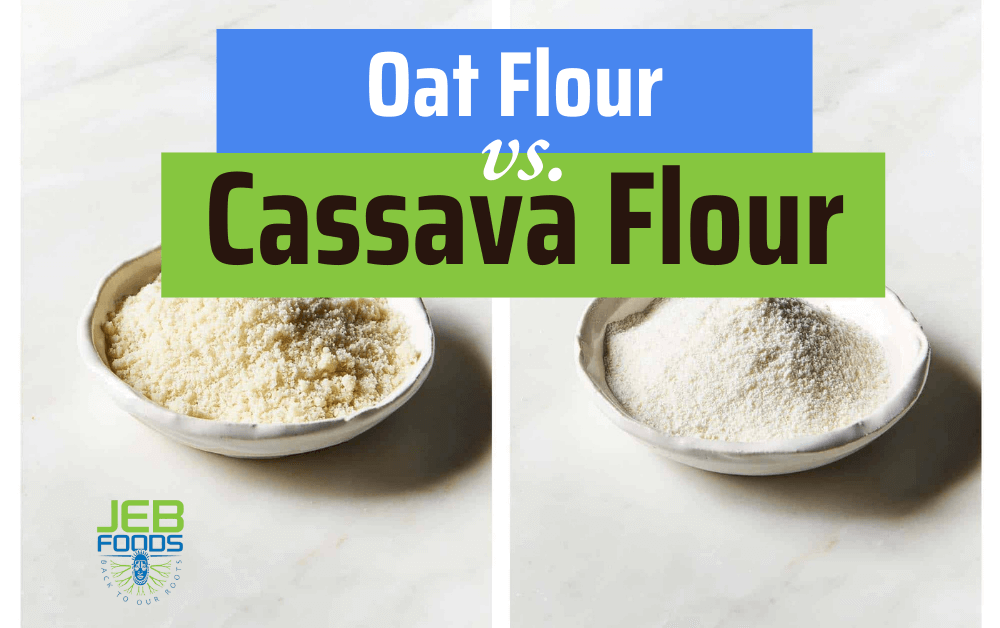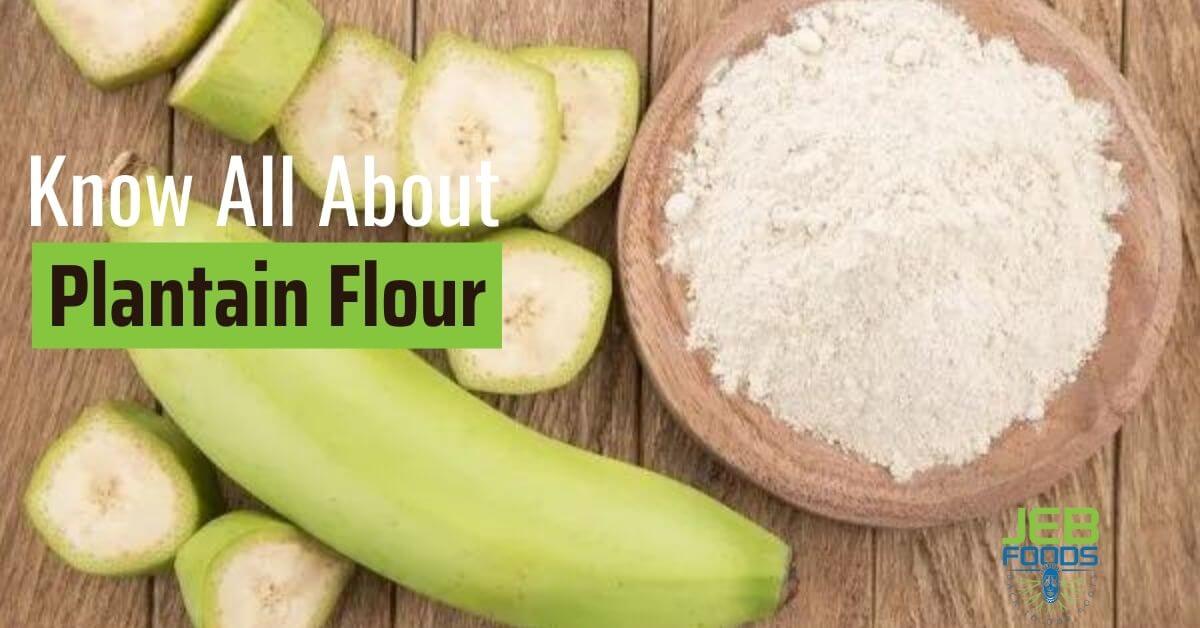Let us see the comparison between Cassava flour vs Oat flour, with my focus on their health benefits, nutrition and when to use each one especially when baking.
Oat Flour is made from ground oats; it’s easy to make at home by grinding gluten-free oats into a fine powder in a blender.
The entire oat is used to make oat flour, so it boosts the nutrition of whole grains. You can stick steel-cut oats into a food processor and blend them until they’re fine.
Most premade oat flours are stone-ground, meaning the oats are crushed into a fine powder by stone, which is less processed than traditional white flour.
Oat flour is a popular alternative to white or wheat flour and it is naturally better for you than white flour.
While it is gluten-free, oat flour is generally well-tolerated by most people, sadly is not tolerated by all Coeliac sufferers (due to containing a protein called avenin which has a similar structure to gluten).
To those with celiac disease or who are sensitive to gluten, oat flour is a blessing.
The Health Benefits of Oat Flour and How It Compares To Cassava Flour
Table of Contents
Toggle1. This flour, like cassava flour, is high in dietary fiber and can help lower cholesterol levels in the body.
When compared to all-purpose flour, oat flour contains a significant quantity of protein and healthy fats.
Not to mention that it is high in healthy carbs and contains a variety of vitamins and minerals.
The amount of minerals present in oat flour is the first health advantage of this type of wheat. Manganese has the greatest concentration of minerals.
Phosphorus, magnesium, and copper come next. It also has higher-than-average levels of iron, zinc, and B vitamins. Potassium and calcium will also be detected.
2. It is high in antioxidants, which can help prevent premature cellular degeneration.
3. Oat flour contains soluble fiber, which promotes the development of beneficial microorganisms. It is good for your digestive system.
4. It can also benefit people with diabetes by lowering blood sugar levels and lowering LDL cholesterol.
5. Can help you lose weight since it makes you feel fuller after eating anything containing oats.
6. Also it makes you feel fuller for a longer time: Consuming oats or products made from oats like organic oat flour can help you feel full for longer.
7. It means that you can avoid unnecessary snacking, control your appetite, and maintain a healthy weight.
Oat flour is both soluble and insoluble fiber, lowering the risk of coronary heart disease or cardiovascular disease. As a result, including organic oat flour into your diet will aid in the prevention of heart disease.
Organic oat flour is beneficial because it includes beta-glucans, which help decrease harmful cholesterol.
Because beta-glucan is a highly sticky soluble fiber, it reduces the absorption of harmful cholesterol as it passes through the small intestine.
When taken in moderation, oats have been shown in studies to assist patients with diabetes or blood sugar problems in regulating their blood sugar levels.
According to research, including oats in your diet can help lower systolic and diastolic blood pressure, particularly if you have moderate or borderline hypertension.
It indicates that oat flour prepared from pure whole oats can aid in the normalization of your blood pressure levels.
It can lower the risk of getting asthma, as well as avoid constipation and diarrhea. Your body will receive the advantages of this excellent food source by incorporating a modest quantity of oat flour into your regular diet.
Gluten Intolerance
If you find yourself becoming blotchy or getting a runny nose after eating a bowl of oatmeal, you may be allergic or sensitive to a protein found in oats.
This protein is called avenin that may cause problems because it has a similar amino-acid structure as gluten. The lipases are activated when crushing or squeezing oat kernels
Coeliac disease patients, oat allergy, and oat sensitivity both trigger an immune system response. The vast majority of gluten-sensitive persons do not respond to avenin.
They have no issues eating clean, uncontaminated oats.
Are Both oat flour and Cassava Flour the same in Use
For baking and cooking, cassava and oat flour are comparable to those done with all-purpose flour. Some baked goods rely significantly on gluten to produce dough or to induce a response that alters the texture and structure of whatever you’re preparing.
Working around this is usually more difficult when using gluten-free flour, and solutions differ from recipe to recipe.
Oat flour and cassava flour can be used in equal parts to replace all-purpose flour in most situations. Oat flour may be utilized in a variety of applications that white flour cannot.
Because of its flavor and texture, white flour does not work well in no-bake recipes.
Oat flour may be utilized to give protein treats more substance, protein, and fiber.
Which is better? Oat flour or cassava flour
Cassava and Oat flour, looking at both flours strictly from the perspective of health benefits,
Whole wheat flour is, without a doubt, the most widely used flour. It’s high in minerals, promotes heart health, and is high in protein and fiber.
Whole wheat flour is beneficial for you, but only if you can tolerate gluten. If you aren’t, you’ll need to use a different flour-like gluten-free cassava flour.
That’s where oat flour and cassava flour shines. But allergies or sensitivities to oats is a drawback. Oat flour is nut-free, making it a valuable alternative for people with nut allergies.
Oat flour is a good choice, but not with every recipe. It makes oat flour the clear winner in the oat flour vs. white flour debate.
Cassava flour comes to mind as a nut-free, gluten-free, and paleo alternative, especially if strict on a specific diet.
It can be substituted with all-purpose flours wheat-based flour and still give the result needed in your recipes. But for gluten-free flour, I always advise you to go for a mix to strike a balance.
See the benefits of gluten-free flour
Cons of oat flour compared to cassava flour
Some oat flour products are labeled gluten-free, while others are not. Oat flour labeled gluten-free may nevertheless contain more than 20 parts per million of gluten.
The distinction is that the “gluten-free” product is produced in a separate section of the plant using equipment that does not share lines with their other wheat manufacturing goods.
Avenin, the protein in oats, is sensitive to a limited number of persons with celiac disease or gluten sensitivity (about 10 to 15%).
As a result, oat flour is not suited for everyone on a gluten-free diet. Be cautious every time to your body and consult your healthcare specialists.

Is oat flour gluten-free
Yes, if you manufacture oat flour from certified gluten-free oats (or buy certified gluten-free oat flour), oat flour is gluten-free.
Because oats can be cross-contaminated by grains grown in neighboring fields or contaminated in the facilities that process and package them, they must be certified gluten-free.
Gluten-free oats have been tested and verified to be gluten-free.
The Nutrition of Oat Flour and how it compares to cassava flour
The glycemic index, estimated by starch hydrolysis of oat flours, ranged from 61 to 67, which increased to 77-86 after heating while cassava flour stood at 91.
1/4 cup equals one serving of oat flour. It has 110 calories, 3 g fiber, 4 g protein, calcium, iron, potassium, thiamin, and riboflavin.
Overall, oat flour has a far higher nutritious value than cassava flour.
Let’s see further break down of their nutritional facts.
| Energy per 20g serving : | Cassava flour | Oat flour |
| Calories / Kilocalories | 71.6 Cal / kcal | 81 |
| Nutrients : | Per 1/8 cup (30ml) | |
| Energy | 231.7kJ (55.4Cal) | |
| Protein | 0.03g | 5.86g |
| Fat Total | 0.003g | 3.6g |
| – saturated | 0.001g | 0.642g |
| – trans fat | 0g | |
| – polyunsaturated fat | 0.001g | 1.332g |
| – monounsaturated fat | 0.001g | 1.146g |
| Cholesterol | 0 mg | |
| Total Carbohydrate | 13.72g | 26.28g |
| Sugars | 0.52g | 0.32g |
| Water | 1.7g | |
| Ash | 0.02g | |
| Dietary Fiber | 0.1g | 2.6g |
| Selenium, Se | 0.1 µg (microgram) | 6.8µg |
| Sodium, Na | 0.18 mg | 3.8mg |
| Potassium, K | 2 mg | 74mg |
| Magnesium, Mg | 0.18 mg | 28mg |
| Phosphorus, P | 1 mg | 90mg |
| Zinc, Zn | 0.02 mg | 0.6mg |
| Calcium, Ca | 3 mg | 11mg |
| Iron, Fe | 0.24 mg | 0.8mg |
| Copper, Cu | 0.003 mg | |
| Manganese, Mn | 0.017 mg | 0.8mg |
| Vitamin C – ascorbic acid | 0 mg | 0mcg |
| Vitamin B6 | 0.001 mg | |
| Foliate – total | 1 µg (microgram) | |
| Choline – total | 0.2 mg | 6.0mg |
| Pantothenic acid | 0.021 mg | |
| Aspartic acid | 0.002 mg | |
| Glutamic acid | 0.004 mg | |
| Vitamin K | 0.6µg | |
| Vitamin A, IU (IU) | 0.0IU | |
| Vitamin A, IU (IU) | 0.0IU | |
| Vitamin C, total ascorbic acid (mg) | 42.4 mg | |
| Thiamin (mg) | 0.087 mg | 0.2mg |
| Riboflavin (mg) | 0.048 mg | |
| Niacin (mg) | 0.854 mg | 0.4mg |
| Vitamin E | 0.2mg | |
| Vitamin B-12 (mcg) | 0.0µg |
* For basic nutrition recommendation, 2,000 calories per day is considered.
Because oats offer great slow-release energy characteristics (low on the glycemic index), they’re also great for breakfast bakes (like my Cacao-Courgette Breakfast Cake) and smoothies, which will keep you going all morning.
Protein, fiber, vitamin E, B vitamins, and calcium are abundant in oats and oat flour. Consuming oats may help lower cholesterol levels, according to some studies.
Always purchase gluten-free oat flour from a certified gluten-free provider to minimize cross-contamination caused by the growing and manufacturing processes.
How Does Cassava Flour Compare In Water Absorption To Wheat Flour
Water absorption refers to the amount of water absorbed by flour to obtain the correct consistency and produce a high-quality end product. It is the ideal amount of water to add to a dough before processing.
The WHC for oat flour with a β-glucan content at 2% was calculated to be 73±7% water absorption capacity stands at 221.8%, while wheat flour has the least at 31.9%.
Final Thought
Oat flour is an extremely versatile cereal grain for those who can eat it. It is a perfect addition to any gluten-free flour mix.
When completely combined, it produces a somewhat ‘glutinous,’ soft feel to the dough, which is ideal for bread.
I’ve used it in a variety of dishes, including this soft gluten-free Oat Bread and this Baguette, as well as these healthful savory Oat Pancakes.
It also adds a wonderful oat flavor and creamy, slightly chewy texture to the whole range of baked goods.




